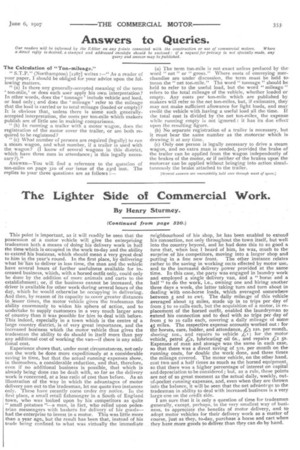The Lighter Side of Commercial Work.
Page 17

If you've noticed an error in this article please click here to report it so we can fix it.
By Henry Sturmey.
This point is important, as it will readily be seen that the possession of a motor vehicle will give the enterprising tradesman both a means of doing his delivery work in half the time which is occupied in the work to-day and the ability to extend his business, which should mean a very great deal to him in the year's round. In the first place, by delivering what he'has to deliver in less time, the man and the vehicle have several hours of further usefulness available for in, creased business, which, with a horsed outfit only, could only be done by the addition of more animals and carts to the establishment; or, if the business cannot be increased, the driver is available for other work during several hours of the day, which he would otherwise be occupying in delivering. And then, by reason of its capacity to cover greater distances in lesser times, the motor vehicle gives the tradesman the ability enormously to widen his sphere of action, and to undertake to supply customers in a very much larger area of country than it was possible for him to deaf with before. This indeed, especially in a town which is the centre of a large country district, is of very great importance, and the increased business which the motor vehicle thus gives the tradesman the ability to do should in itself more than pay any additional cost of working the van—if there is any additional cost.
Experience shows that, under most circumstances, not only can the work be done more expeditiously at a considerable saving in time, but that the actual running expenses show, in themselves, a considerable reduction, and that, therefore, even if no additional business is possible, that which is already being done can be dealt with, so far as the delivery work is concerned, at a less ratio of cost than before. As an illustration of the way in which the advantages of motor delivery pan out to the tradesman, let me quote two instances only. These have recently come under my notice. In the first place, a small retail fishmonger in a South of England town, who was looked upon by his competitors as quite " small potatoes "—a man, in fact, who relied upon pedestrian messengers with baskets for delivery of his goods— had the enterprise to invest in a motor. This was little more than a year ago, but the result has been that instead of his trade being confined_ to :what was virtually the immediate neighbourhood of his shop, he has been enabled to extend his connection, not only throughout the town itself, but well into the country beyond, and he had done this to so good a tune that, when last I heard of him, he was, much to the surprise of his competitors, moving into a larger shop and
putting in a fine new front. The other instance relates rather to the saving in working coEts effected by motor use, and to the increased delivery power provided at the same time. In this case, the party was engaged in laundry work and employed a single delivery van, and a "horse and a half" to do the work, i.e., owning one and hiring another three days a week, the latter taking turn and turn about in dealing with one-horse loads, which averaged somewhere between 5 and so cwt. The daily mileage of this vehicle averaged about 15 miles, made up in so trips per day of from 5 to so calls each, but the acquisition of a motor, in replacement of the horsed outfit, enabled the laundryman to extend his connection and to deal with 20 trips per day of from 5 to to calls each, covering a daily mileage of some 45 miles. The respective expense accounts worked out : for the horses, care, fodder, and attendance, ;63 I25. per month,
shoeing los., and repairs to vehicle for the motor vehicle, petrol 4'2, lubricating oil 6s., and repairs Li 5s. Expenses of man and storage was the same in each case, so that there was a direct saving of 315. per month on the running costs, for double the work done, and three times the mileage covered. The motor vehicle, on the other hand, cost two and a half times as much as the horsed equipment, so that there was a higher percentage of interest on capital and depreciation to be considered ; but, as a rule, these points are not of so great moment as the actual daily, weekly, outof-pocket running expenses, and, even when they are thrown into the balance, it will be seen that the net advantrge to the tradesman in ability to deal with increased business is a very large one on the credit side. I am sure that it is only a question of time for tradesmen generally, except, perhaps, in the very smallest way of business, to appreciate the benefits of motor delivery, and to adopt motor vehicles for their delivery work as a matter of course, just as they, to-day, purchase a horse and cart when they ha_ve more goods to deliver than they can do by hand.






















